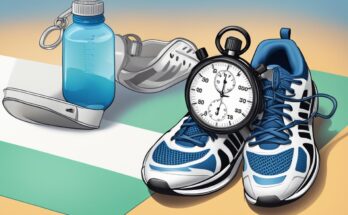Strength training plays a crucial role in a runner’s overall performance. Incorporating exercises that build muscle, increase power, and develop endurance can significantly benefit athletes who focus on running. By engaging in strength training, runners not only improve their speed and power but also enhance their running economy, which is the amount of energy expended at a given pace. The added strength enables runners to maintain proper form, even as fatigue sets in during long distances, reducing the risk of injury and optimizing their performance.

Athletes across various sports recognize the importance of a balanced training regimen, and for runners, this balance includes strength workouts alongside their regular running routines. This combination allows the body to handle the stresses associated with repetitive strides on different terrains. Strength training reinforces the musculoskeletal system, which includes bones, muscles, and connective tissues, providing runners with a more resilient framework to absorb the impact of each footfall.
Moreover, strength training benefits runners by correcting muscular imbalances that can lead to inefficiencies in their stride. Athletes may find that targeting specific muscle groups can alleviate common running-related issues, such as knee pain or IT band syndrome. By engaging in a structured strength training program, runners set the foundation for enhanced athletic performance, leading to better race times and a decreased likelihood of injury.
Fundamentals of Strength Training for Runners

Integrating strength training into a running regimen is essential for improving performance and reducing injury risk.
Benefits of Strength Training in Running
Strength training augments a runner’s capacity by optimizing muscle function and body mechanics. The key benefits include:
- Enhanced Running Economy: By honing muscle strength, runners can use less energy to maintain a given pace, thus extending endurance.
- Increased Power and Speed: Stronger muscles contribute to a powerful stride, enabling faster running speeds.
- Improved Balance and Coordination: Targeting stabilizing muscles leads to better control during running motions.
- Injury Prevention: Reinforcing muscles, tendons, and joints fortifies the body’s ability to withstand the repetitive impacts of running.
- Boosted Muscular Endurance: Resistance training elevates fatigue resistance in muscles, by doing so, prolongs their optimal function during long runs.
Key Strength Exercises for Runners
Incorporating a variety of exercises ensures balanced development of muscle groups vital for running.
- Lower Body Focus:
- Squats: Fundamental for building leg and glute strength.
- Lunges: Enhance leg muscles, promote hip flexibility, and improve balance.
- Calf Raises: Target the calf muscles to boost push-off power.
- Single-leg Deadlifts: Strengthen the hamstrings and improve unilateral stability.
- Core Work:
- Planks: Essential for a strong core, enhancing stability and posture.
- Side Planks: Work on oblique muscles, important for lateral stability.
- Upper Body and Posture:
- Rows: Strengthen back and shoulder muscles, which are crucial for maintaining running posture.
- Deadlifts: Engage the whole body, emphasizing the posterior chain, which is vital for running mechanics.
- Flexibility and Mobility:
- Dynamic stretching: Increases range of motion and readies muscles for the workout.
- Correct Form and Technique: Guidance from a strength and conditioning coach can ensure the effectiveness of strength workouts and prevent injuries.
In summary, the proper combination of lower body, core, and upper body exercises, along with expert coaching on technique, can significantly aid a runner in enhancing their performance and staying injury-free.
Running Specific Strength Considerations

Effective strength training is crucial for runners seeking to optimize performance and reduce injury risk. It enhances muscle balance and running economy, and should be tailored to complement individual running programs.
Incorporating Strength Training into Running Programs
For runners, integrating strength training can lead to significant gains in speed and endurance. Studies conducted by sports scientists, such as Brad Schoenfeld and Kenji Doma from James Cook University in Queensland, Australia, have emphasized the importance of personalized strength routines to improve running efficiency and VO2 max. Key components include:
- Core Strength: Essential for proper running technique and minimizing biomechanical inefficiencies that can lead to injuries, especially around the knees.
- Lower-body Muscles: Focused exercises that target the quads, hamstrings, calves, and glutes can help improve power and flexibility, contributing to better overall balance.
- Intensity and Recovery Balance: The intensity of weight training should be adapted to the running schedule, ensuring adequate recovery to prevent overtraining and injuries.
A well-designed program often involves collaboration between the runner, a running coach, and a strength and conditioning coach to address specific needs and goals.
Balancing Strength Work with Running Mileage
Running coaches and endurance athletes frequently face the challenge of incorporating weights into their regimen without compromising critical long runs and cardiovascular work. Considerations for this delicate balance include:
- Schedule Management: Alternating running days with strength training sessions to allow for muscle recovery and adaptation. Cycling and swimming can serve as low-impact cross-training activities to maintain cardiovascular fitness on non-running days.
- Adapting Training Intensity: Lowering weight room intensity during peak running phases or before key races to prioritize running performance and reduce injury risk.
- Muscle Mass vs. Running Economy: While excessive muscle mass can be detrimental to a runner’s economy, a strategic weight training plan focuses on functional strength rather than hypertrophy.
Ultimately, the goal is to create a synergistic effect between strength training and running, each enhancing the other for a more robust athletic performance.
Injury Prevention and Recovery

Strength training is integral to both preventing injuries and facilitating recovery for runners. It enhances muscle mass and power, improves joint stability, and promotes efficient movement patterns that are essential for runners at all levels, from sprinters to marathoners.
Role of Strength Training in Injury Reduction
Strength training builds resilience in muscles, tendons, and connective tissues, which can help reduce the likelihood of common running-related injuries. It strengthens the muscles surrounding the knees and spine, aiding in the support and stabilization of these areas during running. A particularly important group of muscles for runners is the core, which, when strong, enhances stability and improves gait efficiency.
- Muscles and Joints: Regular weight training enhances the strength of muscles and the integrity of joints, crucial for runners who repetitively stress these areas.
- Technique and Power: Improved musculature from strength training contributes to better running technique and increased power, which in turn can lead to a more efficient stride length and reduced injury risk.
Strength Exercises for Enhanced Recovery
Incorporating specific strength exercises into a runner’s routine can expedite the recovery process after runs and reduce muscle soreness. Key exercises such as squats, glute bridges, and side planks focus on muscle groups that support running mechanics and promote neuromuscular coordination.
- Squats: Target the quadriceps, hamstrings, and glutes, aiding in knee stability.
- Glute Bridges: Strengthen the glutes and help maintain proper pelvis alignment, which is essential for a healthy spine during running.
- Side Plank: Enhances core strength, vital for maintaining balance and reducing the stress on the spine during long-distance runs.
In addition to these exercises, runners may find benefits in integrating mobility work and activities like yoga into their strength routines to improve flexibility and further diminish injury risk.
Advanced Strength Training Strategies
For runners aiming to improve their performance, integrating advanced strength training strategies into their regimen is crucial. These athletes often incorporate heavy weights and high-intensity workouts to enhance muscle mass and power. Effective strength exercises, like squats and lunges, target the lower body, significantly benefiting a runner’s stride.
Emphasis on proper form is paramount to maximize gains and prevent injury. Runners should consult with a coach to ensure that the foundational techniques for lifting heavy weights are well established.
A structured strength training program for runners might include:
- Interval training: Alternating periods of high-intensity exercises with shorter rest times to challenge the muscles and improve neuromuscular coordination.
- Circuit training: Engaging in a sequence of exercises focused on different muscle groups with minimal rest to enhance conditioning.
- Cross training: Participating in varied training modalities to condition different muscle groups and prevent overuse injuries.
Periodized training plans allow runners to progress through different phases of training intensity:
| Phase | Focus |
|---|---|
| Base | Building foundational strength |
| Build | Increasing weights and intensity |
| Peak | Maximizing power and muscle mass |
| Recovery | Allowing for muscle repair and growth |
During the hypertrophy phase, athletes work on increasing muscle size, while the subsequent phases focus more on strength and power development.
To sum up, runners at an elite level must engage in advanced strength training that challenges their body, ensures progressive strength and power gains, and synchronizes with their running goals. Combining proper execution with a strategic approach to training intensity and variation contributes to a runner’s overall physical preparedness and performance.




